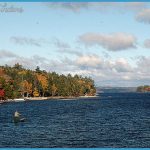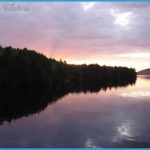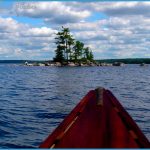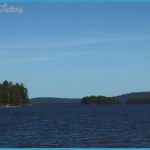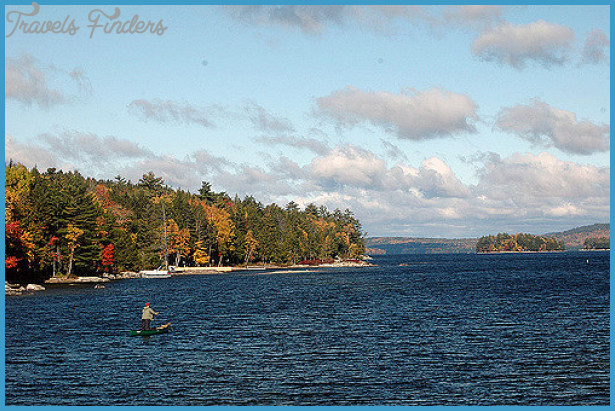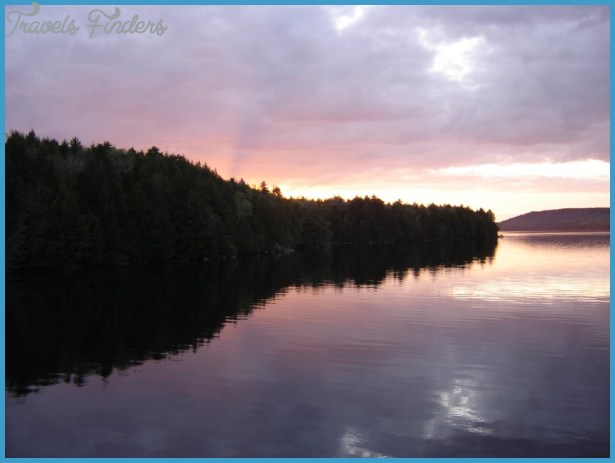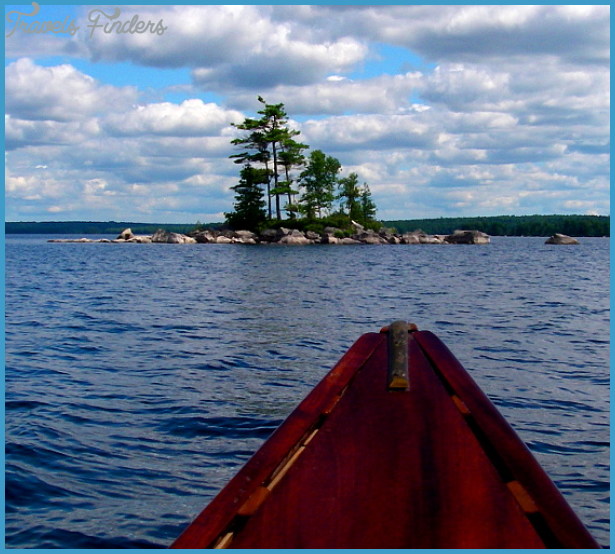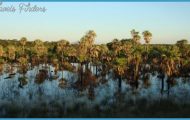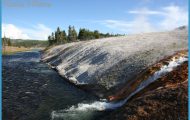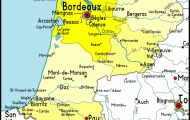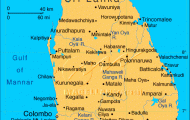Key Species: landlocked salmon, lake trout, smallmouth bass, white perch, whitefish, pickerel
Best Way to Fish: boat, canoe, ramp Best Time to Fish: May through September MAG: 35, B-3
Description: West Grand Lake is big and deep, covering 14,340 acres, with depths up to 128 feet. It is connected to Junior Lake (Site 60) by a water thoroughfarea waterway, without flowage, that connects two bodies of water. The famous Grand Laker canoe, a specialized fishing craft made to accept an outboard motor on its square stern, was designed for use on this lake; modern versions as well as venerable specimens can be seen here.
There is little opportunity to fish from shore. Boats should be at least 14 feet long, with lengths of 16 feet or more preferred for safety. West Grand Lake can become a raging sea during windstorms. Special regulations include a slot limit on bass and a no-kill, artificials-only season from October 1 through October 15. Lodging is available in Grand Lake Stream. Marks, Hardwood, and Kole Kill islands offer primitive campsites.
Fishing index: As soon as the ice leaves, usually sometime in late April or early May, West Grand Lake comes alive with anglers seeking landlocked salmon. Trolling, either with streamer flies or live smelt, is the most common method. When the water warms up, usually sometime in June, anglers use deep-trolling tactics for landlocked salmon and lake trout, although it is possible to take the occasional fish near the surface at any time. These tactics include smelt fished with downriggers, and lake trolls or dodgers fished with a lead-core line, with a smelt, minnow, or small fly such as Jerry’s smelt for bait. Popular spots for landlocked salmon include Whitney Cove, Bear Island, The Narrows, Norway Point, and Marks and Hardwood islands.
Lake trout sometimes offer trollers an unexpected bonus.The water in the middle of West Grand Lake is uniformly deep (generally more than 60 feet), perfect for summertime lake trout fishing.
Smallmouth bass, until recently a universally ignored species, are on the spawning beds in June and offer fantastic fishing. When fishing for smallmouths, ultralight spinning tackle fans use Mepps spinners, small lead-head jigs (yellow and chartreuse are the best colors for the jig bodies), tiny Rapalas, and small casting spoons such as the Dardevle. Fly rodders use small poppers and deer-hair bugs, woolly buggers, and leech patterns. With a rocky shoreline, plus many points, coves, and islands, the entire lake offers good smallmouth bass fishing. Pug Lake, a narrow finger of Junior Bay in the northwest part of West Grand Lake, is a favorite spot.
In summer, look for white perch near the shore in relatively shallow water. Daytime fishing with small rubber-bodied jigs and live bait gets results, as does evening fishing with dry flies.
Directions: From Princeton, drive north on U.S. Route 1 and take the first left. Follow this road to the village of Grand Lake Stream. The boat landing is at the foot of the lake, right in the village. An alternate landing is located in Whitney Cove, accessible by Amazon Mountain Road, the same road used to get to Lower Oxbrook Lake (Site 59).
For more information: Call the Maine Department of Inland Fisheries & Wildlife in Machias.
Lower Oxbrook Lake is best fished by canoe. White perch, salmon, and brook trout provide plenty of sport on this wilderness lake.

